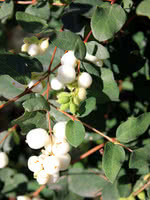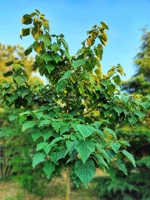Mon-Fri 9am - 5pm Mountain time
Common Snowberry vs Empress Tree
Symphoricarpos albus
Paulownia tomentosa
Common Snowberry is a small deciduous shrub with characteristic white to pink flowers and clusters of white fruit.
This North American native species is very adaptable, and can be used for erosion control in riparian and restoration areas. Snowberry's fruit attracts wildlife, and livestock can consume the berries without issue.
The Empress Tree is a fast growing, ornamental shade tree. It has purple, fragrant flowers that are quite attractive. The flowers emerge before the leaves in early spring. The leaves of this tree can grow very large, up to 30 cm long.
As one of the fastest growing trees in the world, this tree has been given considerable attention for carbon sequestration projects. It drops many seeds which can make it invasive in warmer climates. Please do some research and plant the right tree in the right place.
The Empress tree’s genus name comes from Princess Paulowna, daughter of Tsar Paul I of Russia.
Common Snowberry Quick Facts
Empress Tree Quick Facts
Toxicity: berries toxic to humans

